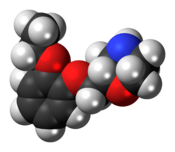 | |
 | |
| Clinical data | |
|---|---|
| Trade names | Qelbree, others |
| Other names | ICI-58834; SPN-812; SPN-809 |
| License data |
|
| Routes of administration | By mouth |
| Drug class | Antidepressant; Norepinephrine reuptake inhibitor |
| ATC code | |
| Legal status | |
| Legal status | |
| Pharmacokinetic data | |
| Protein binding | 76–82%[1] |
| Metabolism | Hydroxylation (CYP2D6), glucuronidation (UGT1A9, UGT2B15)[1] |
| Metabolites | 5-Hydroxyviloxazine glucuronide[1] |
| Elimination half-life | IR: 2–5 hours[2] ER: 7.02 ± 4.74 hours[1] |
| Excretion | Urine (~90%), feces (<1%)[1][3] |
| Identifiers | |
| |
| CAS Number |
|
| PubChem CID | |
| DrugBank |
|
| ChemSpider | |
| UNII |
|
| KEGG | |
| ChEBI | |
| ChEMBL | |
| CompTox Dashboard (EPA) | |
| ECHA InfoCard | 100.051.148 |
| Chemical and physical data | |
| Formula | C13H19NO3 |
| Molar mass | 237.299 g·mol−1 |
| 3D model (JSmol) | |
| Chirality | Racemic mixture |
| |
| |
| | |
Viloxazine, sold under the brand name Qelbree among others, is a selective norepinephrine reuptake inhibitor medication which is used in the treatment of attention deficit hyperactivity disorder (ADHD) in children and adults.[1][5] It was marketed for almost 30 years as an antidepressant for the treatment of depression before being discontinued and subsequently repurposed as a treatment for ADHD.[6][5][1] Viloxazine is taken orally.[1] It was used as an antidepressant in an immediate-release form and is used in ADHD in an extended-release form,[6][1] latterly with comparable effectiveness to atomoxetine and methylphenidate.[7][8][9]
Side effects of viloxazine include insomnia, headache, somnolence, fatigue, nausea, vomiting, decreased appetite, dry mouth, constipation, irritability, increased heart rate, and increased blood pressure.[1] Rarely, the medication may cause suicidal thoughts and behaviors.[1] It can also activate mania or hypomania in people with bipolar disorder.[1] Viloxazine acts as a selective norepinephrine reuptake inhibitor (NRI).[6][1][5] The immediate-release form has an elimination half-life of 2.5 hours[6][2] while the half-life of the extended-release form is 7 hours.[1]
Viloxazine was first described by 1972[10] and was marketed as an antidepressant in Europe in 1974.[6][11] It was not marketed in the United States at this time.[12] The medication was discontinued in 2002 for commercial reasons.[6][13][14] However, it was repurposed for the treatment of ADHD and was reintroduced, in the United States, in April 2021.[6][15][16] Viloxazine is a non-stimulant medication; it has no known misuse liability and is not a controlled substance.[1]
- ^ a b c d e f g h i j k l m n o p "Qelbree- viloxazine hydrochloride capsule, extended release". DailyMed. Archived from the original on 28 October 2022. Retrieved 3 May 2022.
- ^ a b Pinder RM, Brogden RN, Speight TM, Avery GS (June 1977). "Viloxazine: a review of its pharmacological properties and therapeutic efficacy in depressive illness". Drugs. 13 (6): 401–421. doi:10.2165/00003495-197713060-00001. PMID 324751. S2CID 44804763.
- ^ Case DE, Reeves PR (February 1975). "The disposition and metabolism of I.C.I. 58,834 (viloxazine) in humans". Xenobiotica; the Fate of Foreign Compounds in Biological Systems. 5 (2): 113–129. doi:10.3109/00498257509056097. PMID 1154799.
- ^ "SID 180462". PubChem Substance Summary. U.S. National Library of Medicine. Archived from the original on 14 June 2013. Retrieved 5 November 2005.
- ^ a b c Cutler AJ, Mattingly GW, Jain R, O'Neal W (April 2022). "Current and future nonstimulants in the treatment of pediatric ADHD: monoamine reuptake inhibitors, receptor modulators, and multimodal agents". CNS Spectrums. 27 (2): 199–207. doi:10.1017/S1092852920001984. PMID 33121553.
- ^ a b c d e f g Findling RL, Candler SA, Nasser AF, Schwabe S, Yu C, Garcia-Olivares J, et al. (June 2021). "Viloxazine in the Management of CNS Disorders: A Historical Overview and Current Status". CNS Drugs. 35 (6): 643–653. doi:10.1007/s40263-021-00825-w. PMC 8219567. PMID 34003459.
{{cite journal}}: CS1 maint: overridden setting (link) - ^ Schein J, Cloutier M, Gauthier-Loiselle M, Catillon M, Xu C, Chan D, et al. (June 2024). "Assessment of centanafadine in adults with attention-deficit/hyperactivity disorder: A matching-adjusted indirect comparison vs lisdexamfetamine dimesylate, atomoxetine hydrochloride, and viloxazine extended-release". Journal of Managed Care & Specialty Pharmacy. 30 (6): 528–540. doi:10.18553/jmcp.2024.30.6.528. PMC 11145007. PMID 38824626.
- ^ Cite error: The named reference
Faraone_2021was invoked but never defined (see the help page). - ^ Cite error: The named reference
Bushe_2016was invoked but never defined (see the help page). - ^ Cite error: The named reference
pmid4558457was invoked but never defined (see the help page). - ^ Cite error: The named reference
OlivierSoudijn2000was invoked but never defined (see the help page). - ^ Cite error: The named reference
Dahmenwas invoked but never defined (see the help page). - ^ Cite error: The named reference
Williamswas invoked but never defined (see the help page). - ^ Cite error: The named reference
Cochrane2008was invoked but never defined (see the help page). - ^ "Qelbree: FDA-Approved Drugs". U.S. Food and Drug Administration (FDA). Archived from the original on 2 April 2021. Retrieved 2 April 2021.
- ^ "Supernus Announces FDA Approval of Qelbree (SPN-812) for the Treatment of ADHD". Supernus Pharmaceuticals (Press release). 2 April 2021. Archived from the original on 6 April 2021. Retrieved 3 April 2021.